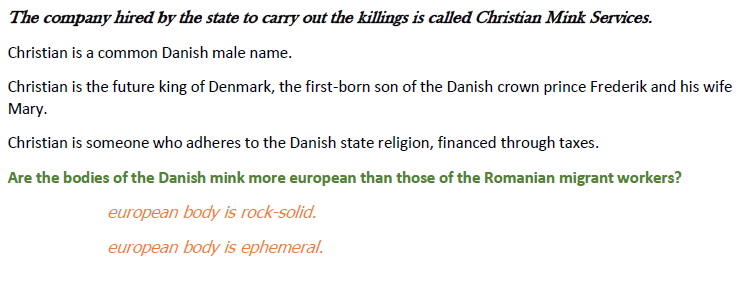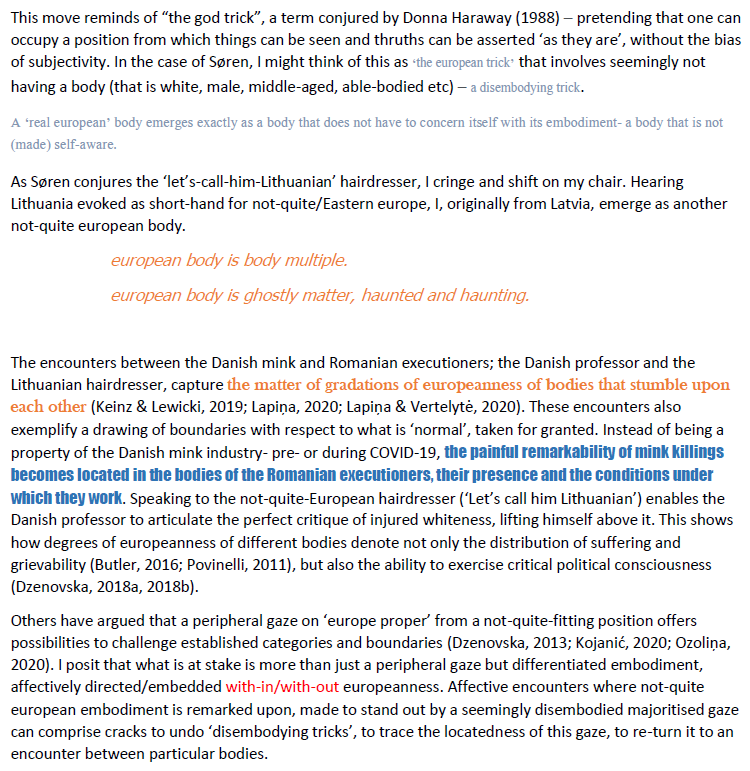tracing european bodies
Linda Lapiņa, Roskilde University



Creative Commons Attribution-Noncommercial-No Derivative Works 3.0 License


Notes
[1] The spellings of europe and european bodies in this text are inspired by an editorial by Anika Keinz and Pawel Lewicki from AJEC (2019) where the authors use small letters for european and the eu (European Union) and italicise the terms white and whiteness in order to interrupt the reading flow and eurocentric ways of reading, in turn following the proposition of Maureen Marsha Eggers, Grada Kilomba, Peggy Piesche and Susan Arndt in their book Mythen, Masken und Subjekte: Kritische Weißseinsforschung in Deutschland (2005). I also use different font styles and colors as affective devices – for instance, in order to facilitate a sense of disruption and disorientation. In addition, I employ these graphic effects to counter expectations of a linear narrative and make more room for plurivocality and fragmentation.
[2] https://politi.dk/nordjyllands-politi/nyhedsliste/lbs091020/2020/10/09, accessed on October 27, 2020.
[3] The name and some details have been changed to ensure anonymity.
References
Butler, J. (2016). Frames of war: When is life grievable? London and New York: Verso.
Dzenovska, D. (2013). Historical agency and the coloniality of power in postsocialist Europe. Anthropological Theory, 13(4), 394–416. https://doi.org/10.1177/1463499613502185.
Dzenovska, D. (2018a). “Latvians do not understand the Greek people”. Europeanness and Complicit Becoming in the Midst of Financial Crisis. In K. Loftsdóttir, A. L. Smith, & B. Hipfl (Eds.), Messy Europe: Crisis, Race and Nation-State in a Postcolonial World (pp. 53–76). New York & Oxford: Berghahn Books.
Dzenovska, D. (2018b). School of Europeanness: Tolerance and other lessons in political liberalism in Latvia. Ithaca (NY): Cornell University Press.
Eggers, M.M., Kilomba, G., Piesche, P. & Arndt, S. (2005). Mythen, Masken und Subjekte: Kritische Weißseinsforschung in Deutschland. Münster: Unrast Verlag.
Haraway, D. (1988). Situated Knowledges: The Science Question in Feminism and the Privilege of Partial Perspective. Feminist Studies, 14(3), 575–599.
Keinz, A., & Lewicki, P. (2019). European Bodies: Who Embodies Europe? Explorations into the Construction of European Bodies. Anthropological Journal of European Cultures, 28(1), 7–24. https://doi.org/10.3167/ajec.2019.280104.
Kojanić, O. (2020). What can the Anthropology of Postsocialism Offer to the Anthropology of European Peripheries. Anthropological Journal of European Cultures, 29(2), 49–66. https://doi.org/10.3167/ajec.2020.290204.
Lapiņa, L. (2020). Sexual Harassment or Volunteer Work? Affordances of Differentiated Whiteness. Intersections. East European Journal of Society and Politics, 6(3). https://doi.org/10.17356/ieejsp.v6i3.633.
Lapiņa, L., & Vertelytė, M. (2020). ‘Eastern European’, Yes, but How? Autoethnographic Accounts of Differentiated Whiteness. NORA – Nordic Journal of Feminist and Gender Research, 1–14. https://doi.org/10.1080/08038740.2020.1762731.
Ozoliņa, L. (2020). Sight and Touch between East and West. Ethics, Ethnography and Social Theory. Anthropological Journal of European Cultures, 29(2), 102–107. https://doi.org/10.3167/ajec.2020.290208.
Povinelli, E. A. (2011). Economies of Abandonment. Durham (NC): Duke University Press.